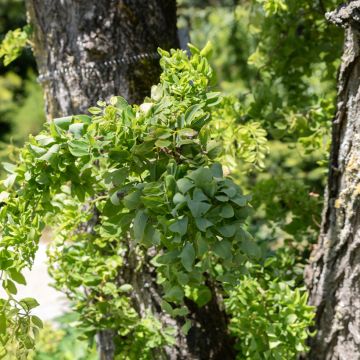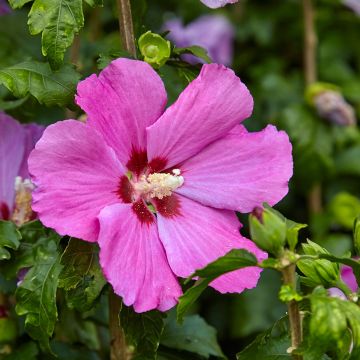

Robinia pseudoacacia Frisia - Black Locust


Robinia pseudoacacia Frisia - Black Locust


Robinia pseudoacacia Frisia - Black Locust
Robinia pseudoacacia Frisia - Black Locust
Robinia pseudoacacia Frisia
False acacia, Black Locust, Locust Tree
Hello, Despite the very appreciable efforts of the wonderful teams at Promesses de fleurs, whom I sincerely thank for their professionalism and attention... and despite a very rewarding commercial gesture... I am skeptical and quite disappointed. The plants delivered are thin, fragile cuttings that easily get damaged, as the trunk has been systematically damaged in several places in the delivery box on both orders. I had to apply a very thin layer of pine tar to protect the wounds. Nice grafting done, although I don't understand why graft it when propagating it from its own roots would have been just as effective, if not better, especially considering it is grafted onto a standard Robinia pseudoacacia. So, a low price, but the quality of this specific plant is equally low. The packaging will not prevent the plant from being affected by the current chaotic transportation. In any case, thank you to Promesse de Fleurs for their efforts... despite everything.
Maxime , 29/12/2022
Special offer!
Receive a €20 voucher for any order over €90 (excluding delivery costs, credit notes, and plastic-free options)!
1- Add your favorite plants to your cart.
2- Once you have reached €90, confirm your order (you can even choose the delivery date!).
3- As soon as your order is shipped, you will receive an email containing your voucher code, valid for 3 months (90 days).
Your voucher is unique and can only be used once, for any order with a minimum value of €20, excluding delivery costs.
Can be combined with other current offers, non-divisible and non-refundable.
Home or relay delivery (depending on size and destination)
Schedule delivery date,
and select date in basket
This plant carries a 24 months recovery warranty
More information
We guarantee the quality of our plants for a full growing cycle, and will replace at our expense any plant that fails to recover under normal climatic and planting conditions.
Would this plant suit my garden?
Set up your Plantfit profile →
Description
Robinia pseudoacacia 'Frisia', sometimes called Golden Acacia, is a particularly bright variety of false acacia, with its foliage changing from spring to autumn. This beautiful deciduous tree has a flexible and airy habit and delicate foliage that provides light shade without harming companion plants. It spring, it is covered in gold and white clusters. Its beautiful, highly scented and edible flowering is also highly appreciated by bees. This false acacia owes its success to its ease of cultivation in any soil and under almost all climates, except in very windy regions as its wood is brittle.
Robinia pseudoacacia 'Frisia' is a horticultural variety derived from Robinia pseudoacacia, a tree native to the Eastern United States. It belongs to the Fabaceae family. These plants are capable of assimilating atmospheric nitrogen through their roots and therefore do not need to draw it from the soil, which allows them to grow in poor environments. 'Frisia', with a smaller growth than the species, has particularly bright and changing foliage, in various shades of yellow. It is a long-lived tree with a columnar habit in its early years, with a loosely rounded crown as it matures. Fast-growing, 'Frisia' will reach an average height of 8 m (26.2 ft) with a spread of 4 m to 5 m (13.1 ft to 16.4 ft). The bark, initially smooth, develops an interesting fissured texture with age. The branches are strong but brittle, and some are armed with thorns. Its deciduous leaves, measuring 15 cm to 20 cm (5.9 in to 7.9 in) long, are divided into about twenty leaflets. They are highly decorative, transitioning from spring yellow to acidic green in summer, before turning yellow-amber, ochre or orange in autumn. Flowering takes place in May, on individuals about ten years old. The abundant pendulous inflorescences measure 10 cm to 20 cm (3.9 in to 7.9 in) long, and consist of white papilionaceous flowers that harmonise perfectly with the yellow foliage. This orange-scented flowering attracts pollinating insects. The flowers can be used in cooking. It is followed by the formation of flat, reddish pods containing a few rare brown bean-shaped seeds.
Please note that only the flowers are edible, the rest of the plant is highly toxic.
Robinia pseudoacacia 'Frisia' is suitable for both small and large gardens, but it is not recommended in windy locations. Planted as a specimen tree in a small garden, it also thrives on slopes or in free hedges in a large garden. It is commonly used as an ornamental tree along avenues. It can be planted against a backdrop of evergreen shrubs or conifers (cypress, thuja, yew, juniper). It can also be planted in a flowered grove with poor soil alongside other low-maintenance and highly ornamental trees or shrubs, such as Sophora davidii, broom, Indigofera gerardiana, a red oak (Quercus robur 'Purpurascens') or a purple hazel.
Robinia pseudoacacia Frisia - Black Locust in pictures






Plant habit
Flowering
Foliage
Botanical data
Robinia
pseudoacacia
Frisia
Papilionaceae
False acacia, Black Locust, Locust Tree
Cultivar or hybrid
Other Robinia - Black Locust
View all →Planting and care
Robinia pseudoacacia 'Frisia' is easy to cultivate in all regions. It thrives in the sun, sheltered from strong winds and sea spray as its branches are brittle and the wind can damage its flowering. The soil should be light and well-drained, even poor, preferably moist. However, this variety tolerates summer drought once established. It cannot tolerate excessive limestone and clay, which suffocate the roots. Its resistance to atmospheric pollution is excellent, making it valuable in urban areas. From August to October, prune dead or weak wood to prevent sap bleeding. Also remove branches that cross within the canopy to maintain its proper habit. Beware of voles that love bark and attack the base of plants.
Planting period
Intended location
Care
Planting & care advice
-
, onOrder confirmed
Reply from on Promesse de fleurs
Similar products
Haven't found what you were looking for?
Hardiness is the lowest winter temperature a plant can endure without suffering serious damage or even dying. However, hardiness is affected by location (a sheltered area, such as a patio), protection (winter cover) and soil type (hardiness is improved by well-drained soil).

Photo Sharing Terms & Conditions
In order to encourage gardeners to interact and share their experiences, Promesse de fleurs offers various media enabling content to be uploaded onto its Site - in particular via the ‘Photo sharing’ module.
The User agrees to refrain from:
- Posting any content that is illegal, prejudicial, insulting, racist, inciteful to hatred, revisionist, contrary to public decency, that infringes on privacy or on the privacy rights of third parties, in particular the publicity rights of persons and goods, intellectual property rights, or the right to privacy.
- Submitting content on behalf of a third party;
- Impersonate the identity of a third party and/or publish any personal information about a third party;
In general, the User undertakes to refrain from any unethical behaviour.
All Content (in particular text, comments, files, images, photos, videos, creative works, etc.), which may be subject to property or intellectual property rights, image or other private rights, shall remain the property of the User, subject to the limited rights granted by the terms of the licence granted by Promesse de fleurs as stated below. Users are at liberty to publish or not to publish such Content on the Site, notably via the ‘Photo Sharing’ facility, and accept that this Content shall be made public and freely accessible, notably on the Internet.
Users further acknowledge, undertake to have ,and guarantee that they hold all necessary rights and permissions to publish such material on the Site, in particular with regard to the legislation in force pertaining to any privacy, property, intellectual property, image, or contractual rights, or rights of any other nature. By publishing such Content on the Site, Users acknowledge accepting full liability as publishers of the Content within the meaning of the law, and grant Promesse de fleurs, free of charge, an inclusive, worldwide licence for the said Content for the entire duration of its publication, including all reproduction, representation, up/downloading, displaying, performing, transmission, and storage rights.
Users also grant permission for their name to be linked to the Content and accept that this link may not always be made available.
By engaging in posting material, Users consent to their Content becoming automatically accessible on the Internet, in particular on other sites and/or blogs and/or web pages of the Promesse de fleurs site, including in particular social pages and the Promesse de fleurs catalogue.
Users may secure the removal of entrusted content free of charge by issuing a simple request via our contact form.
The flowering period indicated on our website applies to countries and regions located in USDA zone 8 (France, the United Kingdom, Ireland, the Netherlands, etc.)
It will vary according to where you live:
- In zones 9 to 10 (Italy, Spain, Greece, etc.), flowering will occur about 2 to 4 weeks earlier.
- In zones 6 to 7 (Germany, Poland, Slovenia, and lower mountainous regions), flowering will be delayed by 2 to 3 weeks.
- In zone 5 (Central Europe, Scandinavia), blooming will be delayed by 3 to 5 weeks.
In temperate climates, pruning of spring-flowering shrubs (forsythia, spireas, etc.) should be done just after flowering.
Pruning of summer-flowering shrubs (Indian Lilac, Perovskia, etc.) can be done in winter or spring.
In cold regions as well as with frost-sensitive plants, avoid pruning too early when severe frosts may still occur.
The planting period indicated on our website applies to countries and regions located in USDA zone 8 (France, United Kingdom, Ireland, Netherlands).
It will vary according to where you live:
- In Mediterranean zones (Marseille, Madrid, Milan, etc.), autumn and winter are the best planting periods.
- In continental zones (Strasbourg, Munich, Vienna, etc.), delay planting by 2 to 3 weeks in spring and bring it forward by 2 to 4 weeks in autumn.
- In mountainous regions (the Alps, Pyrenees, Carpathians, etc.), it is best to plant in late spring (May-June) or late summer (August-September).
The harvesting period indicated on our website applies to countries and regions in USDA zone 8 (France, England, Ireland, the Netherlands).
In colder areas (Scandinavia, Poland, Austria...) fruit and vegetable harvests are likely to be delayed by 3-4 weeks.
In warmer areas (Italy, Spain, Greece, etc.), harvesting will probably take place earlier, depending on weather conditions.
The sowing periods indicated on our website apply to countries and regions within USDA Zone 8 (France, UK, Ireland, Netherlands).
In colder areas (Scandinavia, Poland, Austria...), delay any outdoor sowing by 3-4 weeks, or sow under glass.
In warmer climes (Italy, Spain, Greece, etc.), bring outdoor sowing forward by a few weeks.





















































